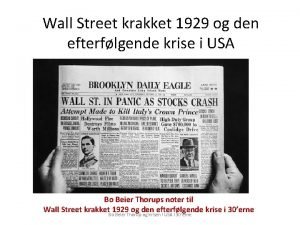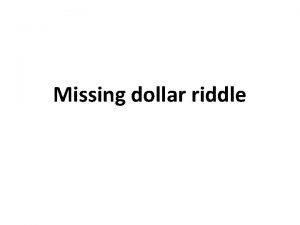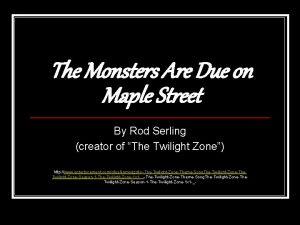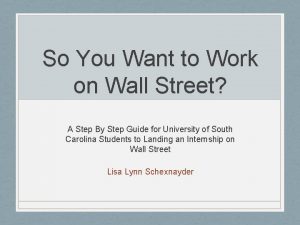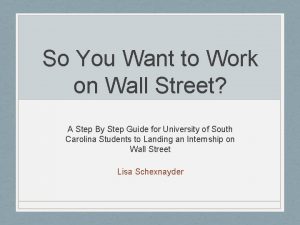Wall Street Worries What keeps you up at


















































- Slides: 50

Wall Street Worries: What keeps you up at night? Presented by: _________ 1

Wall Street Worries… This discussion is offered free of charge. It is designed to be educational in nature and is not intended to provide tax or legal advice. Consult with your tax advisor and/or legal counsel for suitability for your specific situation. Hypothetical and/or actual historical returns contained in this presentation are for informational purposes only and are not intended to be an offer, solicitation, or recommendation. Rates of return are not guaranteed and are for illustrative purposes only. Past performance is no indication of future returns. The DJIA and S&P 500 are not available for direct investment. Projected rates do not reflect the actual or expected performance within any example or financial product. Indexed annuities are products of the insurance industry and are not guaranteed by any bank or insured by the FDIC. Claims paying ability are based on the financial strength of the carrier. Surrender charges may apply to surrenders or withdrawals taken before 59 ½ and in excess of the free withdrawal provisions. Disclosure Insurance products are sold through Dressander/BHC © 2016 Dressander BHC Inc. ; text and materials incorporate or adapt portions of Bat-Socks, Vegas and Conservative Investing © 2010 David P. Vick 2

Agenda • • What Keeps You Up at Night Wall Street Myths ABC Retirement Planning Once is Not Enough 3

What Keeps You Up At Night Can I depend on Social Security? Will my investments provide me enough income in retirement? Will I be able to afford health care? Will I outlive my money? How will fluctuations in the market affect my retirement savings? ? How will I take care of my debt when I retire? What happens if I need Long. Term care? How will inflation affect my nest egg? 4

The Wisdom of Planning • “By failing to prepare, you are preparing to fail. ” ― Benjamin Franklin • “If you don't know where you are going, you'll end up someplace else. ” ― Yogi Berra • “Give me six hours to chop down a tree and I will spend the first four sharpening the axe. ” ― Abraham Lincoln 5

Wall Street Maxims or Myths? 1. I haven’t lost until I sell. 2. The large wire houses are the best place to get professional advice. 3. A diversified allocation of asset classes reduce your overall risk. 4. Buy and hold is an effective conservative strategy. 5. Just buy an index fund. 6. Index Annuities are dangerous. 6

MYTH #1 I haven’t lost until I sell “Realizing gains & losses” A tax reality turned into an investing maxim. (Not a good idea!) 7

MYTH #1 I haven’t lost until I sell “The truth is the market goes up and down. Your accounts may very well recover to their old levels, but until then, “you have what you have” is a better catch phrase to use. Reality is always a better place to begin when evaluating how to move forward. You can even say that you have lost money in your investments and if you keep them they may one day regain their value. I’m sure that’s what the owners of Enron stock said. ” “Bat-Socks, Vegas & Conservative Investing” by David P. Vick 8

MYTH #2 “The large wire houses are the best place to get professional advice” “After a decade of pushing fee-based services, Wall Street is slashing and burning the infrastructure that has supported the business. The moves threaten to damage the long-term health of the wirehouse business model for financial advisers and their clients… “Slash and Burn: The New Wall Street Growth Model” Mark Elzweig, Investment News, November 8, 2009 9

MYTH #2 So, if they’re leaving, who are you listening to now? “…On the new Wall Street, wirehouses are gutting the home office staff that have driven the growth of fee-based business…Even getting a simple phone call returned from the home office is turning into a trial. Forget about one-on -one attention. ” “Slash and Burn: The New Wall Street Growth Model” Mark Elzweig, Investment News, November 8, 2009 10

MYTH #3 A diversified allocation of asset classes reduce your overall risk. “When the tide goes out you find out who’s swimming naked…” - Warren Buffett 11

MYTH #3 A diversified allocation of asset classes reduce your overall risk. A F D E IL Investment Advisor Magazine, July 2009 12

A diversified allocation of asset classes reduce your overall risk. Listen to the editor for Investment Advisor Magazine (July 2009 emphasis mine): “The wealth management practices of Wall Street firms and big banks are broken. Again. To understand this point, it’s important to step back and remember that regardless of which particular investment was the flavor of the month, the common theme heard over and over again in the big investment houses over the past 30 years was that by dividing your assets among many different categories that won’t move in the same direction at the same time, you were going to reduce the overall risk. This premise seemed to have some validity and was appealing to the average investor – until October 2008, when virtually every category except high quality short and intermediate fixed income investments got caught in the same downward draft. Put another way, the Wall Street wealth management model failed its biggest test. Investors who were told that they were diversified suffered losses of double or triple the magnitude of what they were told to expect during a tough year. What went wrong? The fixed income substitutes pushed by the major investment houses – “low volatility” hedge funds, preferred stocks, asset backed securities or other structured products, closed-end bond funds, income/mortgage REITs, and master limited partnerships - weren’t fixed income substitutes at all. None of them is a substitute for the most important characteristic that investors should be looking for from the fixed income portion of their portfolios: safety of principal. MYTH #3 13

14

MYTH #4 “Buy and hold is an effective conservative strategy” “Buy and hold as a strategy is very questionable…It’s worked in the past, but in time of severe market stress it just doesn’t work. ” - Ben Stein 12/28/08 15

MYTH #4 “Buy and hold is an effective conservative strategy” The reality is, if you invested $100 in the S&P 500: 1/1/2008 1/1/2009 1/1/2010 1/1/2011 1/1/2012 1/1/2013 $100 $62 $74 $93 $98 $111 That’s only 2. 2% a year for those 5 years, and a wild ride! Stats from Yahoo. Finance. com 1/7/2013 16

MYTH #5 “Just buy an index fund” S&P 500 Index • January 3 rd, 2000 - 1455. 22 • December 31 st, 2009 - 1115. 10 -23. 37% LOSS!! Stats from Yahoo. Finance. com 2/19/2010 17

MYTH #5 “Just buy an index fund” S&P 500 Index • January 2 nd, 2006 - 1248. 29 • December 31 st, 2015 - 2043. 94 61. 07% Gain 6. 1% a year return over 10 years! Stats from Yahoo. Finance. com 2/3/2016 18

MYTH #5 “Just buy an index fund” ! ! S S E C C U S 19

MYTH #6 “Index Annuities are dangerous” This advice is generally given by the same folks who brought you Myth’s 1 -5!!! 20

MYTH #6 “Index Annuities are dangerous” David F. Babbel Professor of Insurance and Finance The Wharton School of Business University of Pennsylvania Quotes from Tom Cochrane’s Blog on Annuity. Digest. com 8/4/09 & 9/3/09 21

MYTH #6 “Index Annuities are dangerous” Quotes from Tom Cochrane’s Blog on Annuity. Digest. com 8/4/09 & 9/3/09 22

MYTH #6 “Index Annuities are dangerous” 23

WHAT ABOUT INEVITABLE MARKET CHANGES? 24

Ready for the rollercoaster? 25

IN THE NEWS… Yellen Faces Congress amid Direst Threat to Fed Since Dodd-Frank – MSN Money 2/23/15 Why the US stock market is one of the most dangerous in the world – Money. Watch 2/18/15 We're 6 years into 20 -year bull market: Belski, CNBC 11/14/2014 Tech bubble 2. 0? It could happen CNBC 2/25/2015 The Centers for Medicare & Medicaid Services said spending on health care costs from 2014 to 2024 will see an average annual increase of 5. 8%. – The. Street 7/31/15 26

We Live in Perilous Times! On Average • Every 3 years you have a bear market. • Every 8 years you have a significant bear market. • If you hold your money for 17 years you won’t have a problem. • This last bear started in 2000 and ended 2009. “The Anatomy of a Bear” Napier 2005 27

Bull vs. Bear market cycles 28

“Corrections” and “Bear Markets” Global stock prices (January 1, 1980—January 22, 2016) Type of Decline Number Ave. Return Ave. Time from Peak to Trough Correction 12 -13. 7% 87 Days Ave. Time from Trough to Recovery 121 Days Bear Market 7 -33. 4% 373 Days 798 Days Source: Vanguard, Markets & Economies 1/28/16 https: //personal. vanguard. com/us/insights/article/market-correction-vanguard-perspective-012016 29

Accumulation on $500, 000 Inverse Returns Effect Hypothetical Index - Beginning Value $500, 000 Annual End of Year Inverse End of Year Return Value 1 28% $640, 000 -38% $310, 000 2 -10% $576, 000 -12% $272, 800 3 15% $662, 400 2% $278, 256 4 17% $775, 008 15% $319, 994 5 1% $782, 758 26% $403, 193 6 26% $986, 275 1% $407, 225 7 15% $1, 134, 216 17% $479, 453 8 2% $1, 156, 901 15% $547, 921 9 -12% $1, 018, 073 -10% $493, 129 10 -38% $631, 205 28% $631, 205 30

Accumulation on $500, 000 Inverse Returns Effect Hypothetical Index -Beginning Value $500, 000 Withdrawal $35, 000 Inflation 3% Annual End of Year Return Withdrawal Value 1 28% $35, 000 $605, 000 2 -10% $36, 050 $508, 450 3 15% $37, 132 $547, 586 4 17% $38, 245 $602, 430 5 1% $39, 393 $569, 062 6 26% $40, 575 $676, 443 7 15% $41, 792 $736, 118 8 2% $43, 046 $707, 795 9 -12% $44, 337 $578, 522 10 -38% $45, 667 $313, 017 31

Accumulation on $500, 000 Inverse Returns Effect Hypothetical Index Beginning Value $500, 000 Withdrawal $35, 000 Inflation 3% Annual End of Year Return Withdrawal Value 1 -38% $35, 000 $275, 000 2 -12% $36, 050 $205, 950 3 2% $37, 132 $172, 938 4 15% $38, 245 $160, 633 5 26% $39, 393 $163, 004 6 1% $40, 575 $124, 060 7 17% $41, 792 $103, 358 8 15% $43, 046 $75, 816 9 -10% $44, 337 $23, 898 10 28% $45, 667 -$15, 078 32

A Few Questions • Do you know how all of your assets (stocks, bonds, mutual funds, annuities, Life Insurance, etc. ) work together to achieve the amount of risk you want in your total portfolio? • How does your current portfolio protect you in a bear market? • How does the average person determine which assets to use in a conservative portfolio? • What is your plan to manage risk? • Do you need a degree in finance to know how to manage risk? 33

A Plan to Keep Your Retirement Assets from Being Subject to a Repeat of Negative History. 34

• • • Three Green Money Rules: 1% – 3% RED Money 3% – 7%Rules: +30% – -30% Three Rule #1: Protect Your Principal Taxable • Tax-Deferred • Taxable Rule #1: Must be tactical Liquid • Moderately • Liquid Rule #2: Retain Your Gains Bank Liquid • 401 k Rule #2: Must be liquid • IRA’s CDs Rule #3: Guarantee Your Savings • Stock/Bond Checking Rule #3: Must be long term Income 35

1% – 3% • • • Taxable Liquid Bank CDs Savings Checking 10% 3% – 7% • Tax-Deferred • Moderately Liquid 60% +30% – -30% • • • Taxable Liquid 401 k IRA's Stock/Bond 30% 36

What is your client’s greatest priority? is your client willing to give up? Gains? Liquidity? Protection? Cash Protective Growth Risk Growth • Potentially lower returns • Taxable or tax-deferred • Liquid • Potentially moderate returns • Tax-deferred • Offer partial withdrawals Liquidity Protection Gains Liquidity Protection • Potentially higher returns • Taxable or tax-deferred • Offer partial withdrawals or liquid 37

ABCs of Conservative Investing Investor Steve’s Allocation of $600, 000 38

An FIA Simple Four Year Graph 12%+ 8%+ 4% 10% 0% 4% 4% cap Year One Year Two -40% Year Three Year Four 6% 15% Items to Consider: ___Surrender Duration ___Liquidity Options ___Caps ___Income Riders ___Crediting Methods ___Other 39

What if a bear market happens again? Let’s look at 3 different 10 -year periods of market performance to test our ABC Planning Process • 2006 -2015 • 1969 -1978 • 2000 -2009 40

2006 through 2015 Hypothetical and/or actual historical returns contained in this presentation are for informational purposes only and are not intended to be an offer, solicitation, or recommendation. Rates of return are not guaranteed and are for illustrative purposes only. Past performance is no indication of future results. The S&P 500 is not available for direct investment. Chart: Retirement Analyzer Software 2016™ 41

2006 through 2015 $-74, 949 Hypothetical and/or actual historical returns contained in this presentation are for informational purposes only and are not intended to be an offer, solicitation, or recommendation. Rates of return are not guaranteed and are for illustrative purposes only. Past performance is no indication of future results. The S&P 500 is not available for direct investment. Chart: Retirement Analyzer Software 2016™ 42

1969 through 1978 $-74, 949 Hypothetical and/or actual historical returns contained in this presentation are for informational purposes only and are not intended to be an offer, solicitation, or recommendation. Rates of return are not guaranteed and are for illustrative purposes only. Past performance is no indication of future results. The S&P 500 is not available for direct investment. Chart: Retirement Analyzer Software 2016™ 43

1969 through 1978 $-74, 949 $120, 195 Hypothetical and/or actual historical returns contained in this presentation are for informational purposes only and are not intended to be an offer, solicitation, or recommendation. Rates of return are not guaranteed and are for illustrative purposes only. Past performance is no indication of future results. The S&P 500 is not available for direct investment. Chart: Retirement Analyzer Software 2016™ 44

2000 through 2009 $-74, 949 Hypothetical and/or actual historical returns contained in this presentation are for informational purposes only and are not intended to be an offer, solicitation, or recommendation. Rates of return are not guaranteed and are for illustrative purposes only. Past performance is no indication of future results. The S&P 500 is not available for direct investment. Chart: Retirement Analyzer Software 2016™ 45

2000 through 2009 If the next ten years saw a 10%, 20%, or 30% loss in the market, how would it affect $191, 684 your retirement? Hypothetical and/or actual historical returns contained in this presentation are for informational purposes only and are not intended to be an offer, solicitation, or recommendation. Rates of return are not guaranteed and are for illustrative purposes only. Past performance is no indication of future results. The S&P 500 is not available for direct investment. Chart: Retirement Analyzer Software 2016™ 46

What to do? “The first rule is not to lose. The second rule is not to forget the first rule. ” -Warren Buffett 47

It’s All in the Planning “You have had a dream for so many years. Let today be the day you make a plan for it. Just think about how much more likely you are to hit your target when you finally aim at it. ” ― Steve Maraboli, Unapologetically You: Reflections on Life and the Human Experience 48

Once is Not Enough “To improve is to change; to be perfect is to change often. ” ― Winston Churchill Once your plan is implemented, you have to allow for change. Things will happen in your life that require adjustments to your plan. 49

Now What? ? ? 1. Set up an appointment and see how the ABC Process works for you (no obligation!) 2. If you are happy with the results, share your feelings with friends and associates 3. Partner with me to establish a long term, high-value relationship 50
 I hope the days come easy
I hope the days come easy Max isn't home yet. that worries me
Max isn't home yet. that worries me What worries mrs ramsay about jasper
What worries mrs ramsay about jasper Børskrakket 1929
Børskrakket 1929 Donnie azoff
Donnie azoff Bartleby, the scrivener: a story of wall-street
Bartleby, the scrivener: a story of wall-street Konferencja wall street
Konferencja wall street Wall street crash of 1929
Wall street crash of 1929 Wall street journal manufacturing
Wall street journal manufacturing Sound wall instead of word wall
Sound wall instead of word wall Wall to wall chris brown
Wall to wall chris brown Half brick wall vs one brick wall
Half brick wall vs one brick wall Members used to carry wall loads over wall openings
Members used to carry wall loads over wall openings Lemon diagram
Lemon diagram What keeps the sun hot
What keeps the sun hot Romeo and juliet famous quotes
Romeo and juliet famous quotes Holds data instructions and information for future use
Holds data instructions and information for future use 30 dollars for a hotel room riddle
30 dollars for a hotel room riddle Peng wang cheese tofu calories
Peng wang cheese tofu calories Shunt regulator
Shunt regulator To keeps one's temper meaning
To keeps one's temper meaning The rebel disturbs a class *
The rebel disturbs a class * Whoever keeps his life will lose it
Whoever keeps his life will lose it Aleks math intervention
Aleks math intervention Fool birds from hatchet
Fool birds from hatchet Chapter 5 natural laws and car control worksheet answers
Chapter 5 natural laws and car control worksheet answers Type of errors in statistics
Type of errors in statistics Force that keeps each tire from sliding on the road
Force that keeps each tire from sliding on the road A new settlement that keeps close ties to its homeland
A new settlement that keeps close ties to its homeland Stop look and listen before you cross the street
Stop look and listen before you cross the street A piece of gross impertinence
A piece of gross impertinence You hold a picture motionless against a wall
You hold a picture motionless against a wall You say that you love rain
You say that you love rain Eat meals that are nutritious agree or disagree
Eat meals that are nutritious agree or disagree If you think you can you can poem
If you think you can you can poem Tell me what you eat and i shall tell you what you are
Tell me what you eat and i shall tell you what you are I will follow you follow you wherever you may go
I will follow you follow you wherever you may go What is your impression about amerigo's parents
What is your impression about amerigo's parents Literature vocabulary words
Literature vocabulary words 601 south belvidere street
601 south belvidere street Road patterns
Road patterns Sewe
Sewe Boron group number
Boron group number The only man on liberty street summary
The only man on liberty street summary The monsters are due on maple street by rod serling
The monsters are due on maple street by rod serling The house on mango street vocabulary
The house on mango street vocabulary Alicia and i talking on edna's steps
Alicia and i talking on edna's steps Sandra cisneros facts
Sandra cisneros facts The house on mango street my name
The house on mango street my name Rex walls
Rex walls Not laughing out loud candy
Not laughing out loud candy



